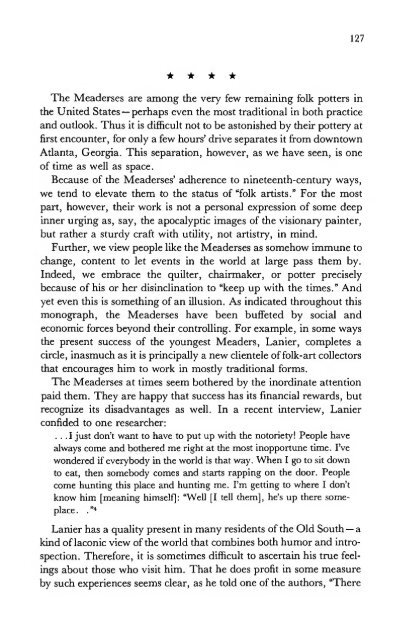Smithsonian Contributions - Smithsonian Institution Libraries
Smithsonian Contributions - Smithsonian Institution Libraries
Smithsonian Contributions - Smithsonian Institution Libraries
Create successful ePaper yourself
Turn your PDF publications into a flip-book with our unique Google optimized e-Paper software.
• • • •<br />
127<br />
The Meaderses are among the very few remaining folk potters in<br />
the United States — perhaps even the most traditional in both practice<br />
and outlook. Thus it is difficult not to be astonished by their pottery at<br />
first encounter, for only a few hours' drive separates it from downtown<br />
Atlanta, Georgia. This separation, however, as we have seen, is one<br />
of time as well as space.<br />
Because of me Meaderses' adherence to nineteenth-century ways,<br />
we tend to elevate them to the status of "folk artists." For the most<br />
part, however, their work is not a personal expression of some deep<br />
inner urging as, say, the apocalyptic images of the visionary painter,<br />
but rather a sturdy craft with utility, not artistry, in mind.<br />
Further, we view people like the Meaderses as somehow immune to<br />
change, content to let events in the world at large pass diem by.<br />
Indeed, we embrace the quilter, chairmaker, or potter precisely<br />
because of his or her disinclination to "keep up with the times." And<br />
yet even diis is something of an illusion. As indicated diroughout this<br />
monograph, the Meaderses have been buffeted by social and<br />
economic forces beyond their controlling. For example, in some ways<br />
the present success of the youngest Meaders, Lanier, completes a<br />
circle, inasmuch as it is principally a new clientele of folk-art collectors<br />
that encourages him to work in mostly traditional forms.<br />
The Meaderses at times seem bothered by the inordinate attention<br />
paid diem. They are happy that success has its financial rewards, but<br />
recognize its disadvantages as well. In a recent interview, Lanier<br />
confided to one researcher:<br />
. . . I just don't want to have to put up widi die notoriety! People have<br />
always come and bothered me right at the most inopportune time. I've<br />
wondered if everybody in the world is that way. When I go to sit down<br />
to eat, then somebody comes and starts rapping on the door. People<br />
come hunting this place and hunting me. I'm getting to where I don't<br />
know him [meaning himself]: "Well [I tell them], he's up there someplace<br />
. . " 4<br />
Lanier has a quality present in many residents of the Old Soum —a<br />
kind of laconic view of the world that combines both humor and introspection.<br />
Therefore, it is sometimes difficult to ascertain his true feelings<br />
about those who visit him. That he does profit in some measure<br />
by such experiences seems clear, as he told one of the authors, "There

















